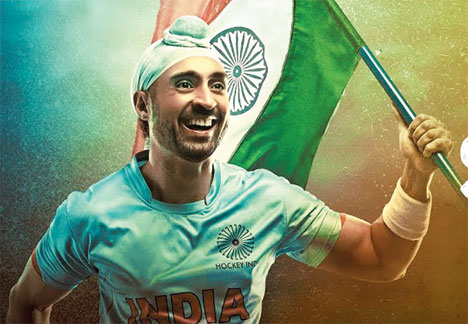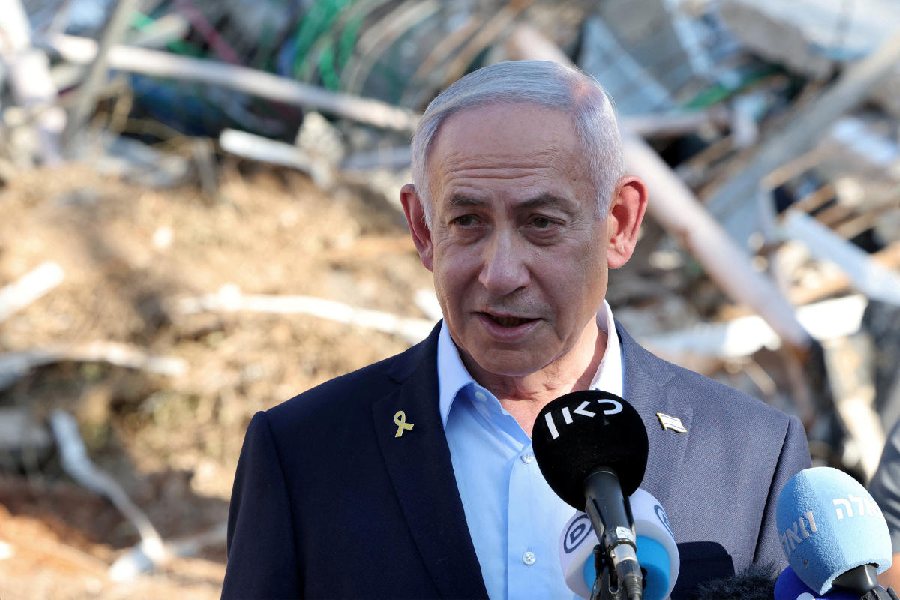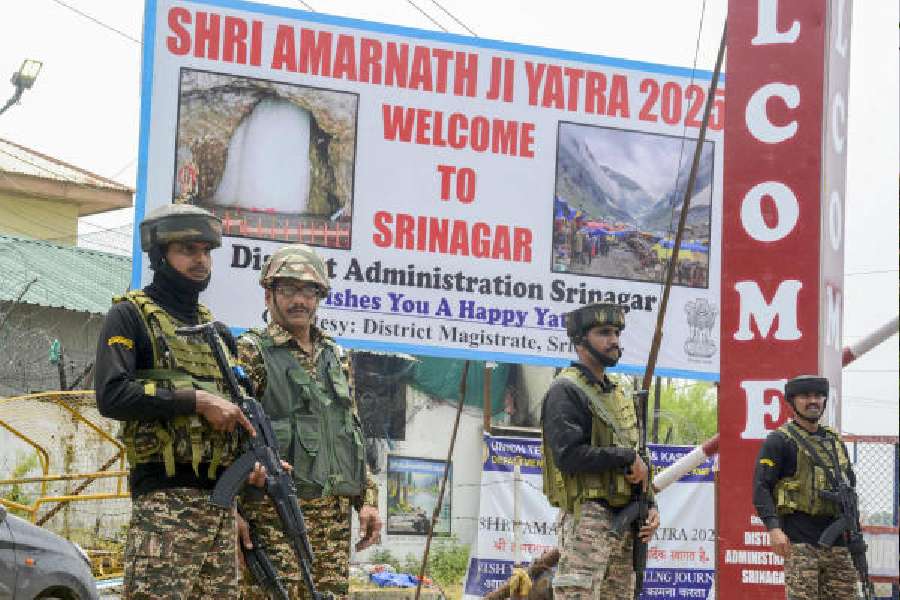
It’s raining biopics in Bollywood. On Friday, Diljit Dosanjh plays Indian hockey player Sandeep Singh in Soorma. Directed by Shaad Ali, Soorma traces Singh’s journey to become a top hockey player, the lows after a gunshot left him paralysed waist down and his subsequent rise from the ashes to reclaim his spot in the national team. t2 met the Punjabi singer-actor in the office of Sony Pictures in Malad in Mumbai to chat about his transformation into a sportsman for the film and his fierce fashion game in real life.
I read somewhere that when you were offered this film, you made a lot of effort to refuse it...
(Laughs) Yes, it’s absolutely true. My main reason was that I’ve never played any sport, leave alone hockey. Apart from Hide-and-Seek, I’ve played nothing else. I was more interested in music. I had heard that Sony and Shaad were making a film on hockey and then I got a call that they wanted to speak to me about a film, I prayed that it wasn’t the hockey film... it turned out to be the hockey film!
I came to this office to refuse the film. I brought four-five friends with me just in case I couldn’t handle the pressure of saying ‘No’. Once the narration started, I kept saying I didn’t want to do the film but my friends kept saying, ‘You must do it!’ The real story of Sandeep paaji is so inspiring that I thought to myself, ‘Let’s learn to play hockey’ (laughs).
Do you remember the first time you held a hockey stick?
On the first day, I was very excited because I got a hockey kit with my name on it. I spent the whole day looking at it and playing with the stick. But when I actually went on to the ground the first time, I realised that I had a long way to go before I actually started playing hockey. I had to first learn every single thing from scratch — getting my stance right, how to hold the stick, how to run and how to stand like a hockey player.
Only much later, I learnt how to hit a shot and the drag flick. It took me 15 days to get my stance right and that’s when I realised how serious the whole thing was. I slowly got into the flow of things. The prep took a month or so before we started shooting and during the two-three months of shoot, I would need to learn something new almost every single day. So I spent a good three-four months playing hockey.

This is your first biopic. Was there any kind of pressure given that you are depicting someone else’s life?
I wasn’t too stressed about the ‘acting’ portions of the film. It was things like getting the right physique to look the part and playing the sport in a believable fashion that were a lot tougher for me. I got stuck on things like my diet because I would get two slices of bread for breakfast, just dal for lunch, and cucumber and eggs for dinner. I wasn’t very bothered about the other parts and how Sandeep paaji would react, also because he was right there with us on set, every single day. We would go to the gym together, eat together. I would ask him questions about how he felt about an incident, what went through his mind and things like that. He would, in fact, call me out mostly on the aspects of playing hockey realistically, when my stance was wrong or I’d hit shots in the wrong way. He’d even call me out when my shots were okay and tell me something like the angle was wrong. And then we’d shoot it again.
His story is incredible and heartbreaking at the same time. What’s your sense of him?
He is a soorma (warrior). They’ve named the film aptly because only a soorma can do what he did. It’s not easy for a normal person to deal with the circumstances he dealt with.
What’s your biggest learning from his life?
Well, I learnt to play hockey. Seriously though, it’s tough. Hearing his story, meeting him was incredible. And then discovering what a strain hockey is on your back, you’re bending and playing all the time. I had a severe backache by the third day itself. I didn’t say anything to him but I would look at him in wonder — here’s a man who got shot in the back, got paralysed for two years, couldn’t walk and then went on to become the team captain and make a world record. You need to have an insane amount of passion to do that. Circumstances like this can completely change people and every person faces tough times, maybe smaller ones. But that’s when life becomes a mirror that shows you the truth of who you are. This was the main reason for me saying ‘Yes’ to the film.
What do you have that kind of passion for?
It has to be music for me. I had a nasal operation when I was very young. I was learning music and tabla at that time. My mother tells me that I was singing Gurdas Maan’s Challa when I was unconscious, and when I saw my bandaged face, my biggest concern was whether the doctor had ruined my voice and whether I’d be able to sing again.
This is your fourth Hindi film in the last two years. Are you more comfortable in the industry today?
It’s okay. I don’t think I’ve really needed a manager here so far. It is true that it’s important to socialise and be seen here, but I don’t think it’s absolutely essential. Whatever’s happened so far is because of Punjabi films and Punjabi music, and my focus is still as much over there as it is here. I’m happy with how things are because I want to continue doing new music and concerts... not getting to do that will make me feel like I’ve been imprisoned and I can’t have that.
Your ‘outfits of the day’ on Instagram have become a fashion bible for a lot of people. How important is fashion to your daily life?
It’s not that important for daily life, I’d say, but when in front of the camera, it becomes important. Being a turbanator, I shouldn’t be less than anyone — films in the past have always depicted people in turbans with humour. When we’d watch Hindi films as kids, they’d always make jokes about sardars and I found that wrong. It’s not at all like that in Punjab — in fact, in college I would get more inspired by guys in turbans. It’s nothing religious, my brother doesn’t wear a turban and I’ve even got a trimmed beard. But it’s important to project what you are in real life on screen, and that’s why fashion is important when in front of a camera.
I know you are a sneakerhead. What’s new in the sneakers world?
Balenciaga’s Triple S are in; they’re a collaboration between Vetements and Reebok. That’s my latest acquisition.

It promises to be an eventful July for Chitrangda Singh. First seen in Sudhir Mishra’s Hazaaron Khwaishein Aisi, the actress is making her debut as a producer with Soorma. t2 spoke to Chitrangda about the film that stars Diljit Dosanjh and Taapsee Pannu and her career choices.
How did you come across Sandeep Singh’s story?
I have to thank Deepak Singh, who’s also my business partner and friends with Sandeep and his family. He introduced us in Delhi. During our conversation, Sandeep mentioned that he was getting honoured by a Punjabi community, and was coming to Mumbai for that. He said he was getting honoured for his professional achievements, but not many people knew about his personal struggle. I asked him what he meant by that and he started telling me his story.
This was sometime in mid-2014, and at the time I was writing two different stories. I thought Sandeep’s was the most dramatic comeback anywhere in the world in competitive sport. It was a story waiting to be told.
Were you already looking at turning producer?
Honestly, I don’t know. I was just writing. I didn’t know if I’d take them to another producer or make them myself. But when Soorma came along, I knew I had to make it for sure. There was a little resistance in the sense that there were a lot of biopics being made at that time and this was yet another sports story. I was also told that ‘This is a hockey film and not too many people knew Sandeep’, so I shouldn’t make it. It took a while to get this film green-lit but once Sony came on board, everything got much, much better because they completely believed in the film.
Shaad Ali is an unlikely choice to direct a sports film...
I think Soorma is more than a sports film. It’s a human story of struggle and triumph. We needed someone who could tell an emotional tale without getting melodramatic. I really liked what Shaad did with Saathiya and Bunty Aur Babli. There’s something very realistic about his films and that’s what we wanted for Soorma.

Were you tempted to cast yourself in the film?
Not at all, simply because Sandeep told me how tough this girl (Harpreet, played by Taapsee Pannu) was — she was already playing state-level hockey. The role required the physicality and body language needed to play a girl from a small town, and to walk and talk like a sportsperson. Plus she had to look like a 20-year-old. I think Taapsee brought that freshness of a small-town girl who could play hockey.
Through your career, you’ve taken long and very frequent breaks. Do you have regrets?
The first time I took a break, it was for about five years because I had a son and it was by choice. At that point, I consciously didn’t want to do movies or pursue an acting career. Then I made a comeback and after three years of working, I took another break in 2013. Certain personal issues had cropped up and I wasn’t getting the kind of work I wanted. So, it was a combination of reasons. I went into a kind of haze and before I knew it, another three years had gone by. I know my career hasn’t fallen into place like it could have, but I have no regrets whatsoever. I’m not that ambitious. For me, it’s important to get my personal life in place and feel settled and rooted before I focus on other things. I’m very happy for having got the love and acknowledgment for my work.
What kept you coming back to films?
Once you become an actor, it’s only when you stay away from it that you realise how much you’re missing and how satisfying this process is. After 2013 and the break that I took, I started writing and it became a very exciting process. Then, having chanced upon Sandeep’s story and having taken it through in the last three years has been full of learning and life lessons — putting this project together has been even more exciting. It’s been a very natural progression and I’ve taken it by the year and let it flow rather than trying to control things.
Your next film as an actress — Saheb, Biwi Aur Gangster 3 is also going to release at the end of July.
This month I’m dying! (Laughs) I’m going crazy right now. After Saheb, Biwi Aur Gangster 3, I’ll have Baazaar (with Saif Ali Khan) at the end of August. I am discussing another acting project after that, probably in October. There’s also a script that I’ve worked on that’s locked. There are exciting times ahead!
Karishma Upadhyay

Pink man Angad Bedi plays Sandeep Singh’s brother Bikramjeet Singh in Soorma. We chatted with Angad on being Bikram and life after his marriage with Neha Dhupia.
Soorma is the story of Sandeep Singh, but his brother Bikramjeet has a big role to play in Sandeep’s rise, fall and subsequent rise again. Were you aware of their story before doing the film?
I didn’t know about his personal life, but I knew who Sandeep Singh was. I’ve followed his graph. I played Under-16 and Under-18 cricket and I would practise at Delhi’s international stadium, aur wahan hockey ke ladke bhi aate thhe. Sandeep would come, so did Bikramjeet and players like Dhanraj Pillay and Sardara Singh. They would all practise there. We all wanted to be as fit as the hockey players.
But I wasn’t aware of the fact that Sandeep got shot in the spine in a freak accident and the support that he got during that phase from Bikramjeet. I didn’t even know that Bikramjeet and Sandeep were brothers… it was Shaad (Ali, Soorma’s director) who told me this later. Bikram’s sacrifices have made Sandeep the player he is today. So it’s a great story. Our biopics generally glorify the person whose life is being captured, but in this film, Bikram is as important.
I’ve never portrayed such a selfless character before. There’s emotion, love, hurt, angst… but it’s all for his brother. He gave up his own hockey for his brother. He loved him like his own son and looked after him, though there is only a year’s gap between the two. When Sandeep got shot and was left paralysed, Bikram stopped playing and started doing two jobs so that he could pay for his treatment. He did everything for his brother, right down to cleaning him and his bed in the hospital. These days, you hardly get siblings like this.
Has playing Bikramjeet changed you in any way?
It has. Shaad’s one-line brief to me was, ‘You have to put Sandeep before yourself’. As actors, we are mostly consumed by how we are looking on screen, our scenes and our lines. But doing this film has changed me. Shaad told me that I had to love Diljit (who plays Sandeep) even off camera. And it happened very organically because I look at Diljit as a brother. We have a great bond and huge respect for each other. We speak the same language and our sense of humour is the same. After we finished shooting, I really missed his presence. He’s a great guy and I hope we can carry on this association.
There have been a few sports biopics made in Bollywood over the last few years. Do you have a favourite?
I thought Bhaag Milkha Bhaag was a great film, but I feel it could have been made a lot better. I think we can do better with our biopics because every time we showcase a person, we don’t really have to glorify him or her. We should show things the way they are. I don’t know why sports biopics have to always end on a glorified note… they can end on a real note too, and that’s what happens in Hollywood.
But that also depends on the person who’s giving the right to make a film on his life. It depends on whether he or she wants which parts of their lives to be shown.
With Pink and Tiger Zinda Hai, your career has been on an upswing. Happy with what you’ve achieved so far?
I am very happy, and I feel I have been lucky too. Pink set the ball rolling and things have been looking good ever since. I have been associated with good projects and have worked with good people. First, I was looking for work and when I got that, I started looking for work where I could perform. After Pink, people started taking me seriously as an actor.

Your marriage to Neha Dhupia in May came as a big surprise. How’s it been so far?
Oh, very good. Marriage happened at the right time for me. It’s nice to come back home to your partner. It’s a really good feeling. We like doing things together. Right now, we are in the process of setting up our new home.
Is it tough to live a relationship that’s in the public eye?
Not really. It depends on how you take it. If you take it too seriously, then it’s tough. We take things very easy. We joke around a lot on social media. We share messages that we feel can be shared on a public domain. There are many people who follow both of us on social media and that helps them feel they are connected to us. But we also enjoy our privacy. We are a relaxed couple and we don’t treat marriage as a burden (smiles).
Priyanka Roy










